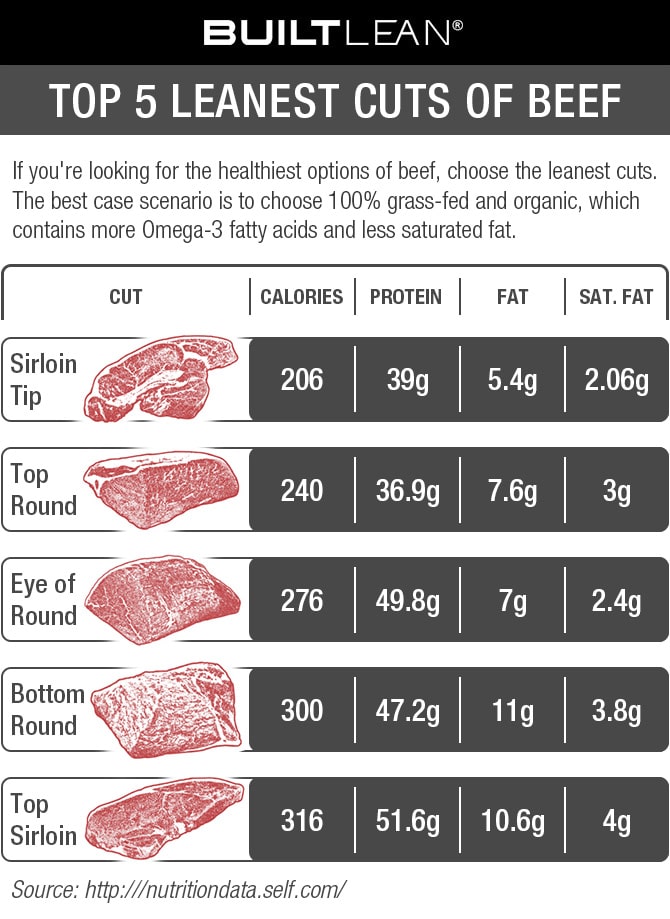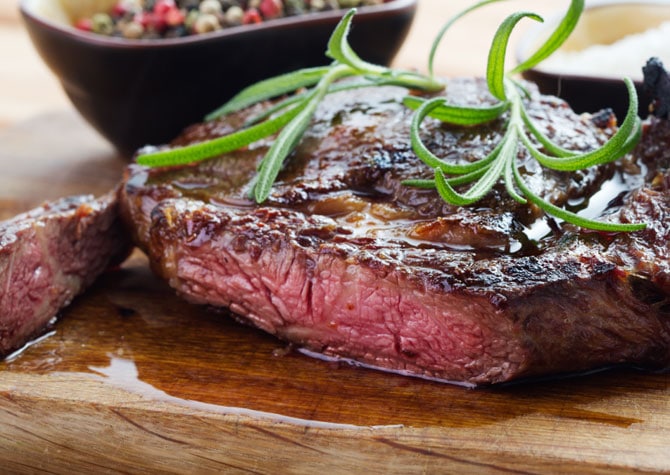What Is the Leanest Beef Steak

A "steak dinner" is practically synonymous with a meal of indulgence and/or success. Some even run to the far corners of the earth – like Argentina, Japan and South Africa – to enjoy the best cuts of the best beef (or at least have it imported). Steak's association with luxury dates back to primal triumph, and has continued to the modern day as an exhibition of financial success.
At the same time almost every health-promoting organization has been advocating that we "eat less meat!" So, why is meat still held to such a high regard in terms of economic status or culinary greatness if it has been stamped with the "unhealthy" tag of doom?
Why Is Red Meat So Controversial?
Red meat, and beef in particular, has been so controversial because of numerous studies demonstrating correlations between the consumption of animal products high in saturated fat and a higher incidence of chronic health conditions.1 This research has led organizations such as the American Heart Association to recommend limiting animal protein consumption- including lean meat, poultry and seafood – to 6oz per day.2 Of all of the animal-based protein sources, red meat generally has the highest saturated fat content.
There is sufficient evidence linking the consumption of processed meat to the development of certain types of cancer. However, a meta-analysis on the epidemiological literature found that the associations between red meat consumption and cancer are weak.3
Even so, the World Health Organization recommends limiting your consumption of red meat.4 But that doesn't mean you need to say goodbye to red meat altogether, especially since it's a good source of several important nutrients.
Is Red Meat Healthy?

Because of all the negative press, the nutritional benefits of beef are often neglected. We forget that beef is chock-full of vitamins and minerals, and plenty of protein, which our bodies need to build and maintain lean muscle. The real question becomes what cuts to eat, and how much.
Most of the time, the cuts you want to opt for are the leanest ones, which are lower in fat but just as delicious and even more nutritious. According to the USDA, beef is defined as "lean" when a 3.5oz serving contains fewer than 5g of total fat, 2g of saturated fat, and 95 mg of cholesterol. These 3.5oz cuts hover around 200-300 calories each and can rack up nearly half of your recommended daily intake of protein (48%). 5
Check out the infograph below for the best options.
Nutritional Benefits of Red Meat
A lean cut of beef also has a much higher concentration of essential vitamins and minerals per oz of meat. Lean cuts of beef are packed with the following: 6
| Iron | Helps your body use oxygen optimally. |
| Vitamins B-6 & B-12 | Maintain proper brain function and energy. |
| Zinc | Builds a strong immune system. |
| Phosphorus | Helps build strong bones and teeth. |
| Choline | Supports nervous system development. |
| Riboflavin | Helps convert food to fuel. |
| Vitamins A & E | Provides antioxidant support. |
How Much Red Meat Should I Eat Per Week?

The next question is "how much" or "how often" you should eat red meat. Different sources give different recommendations for weekly intakes of beef, but the number of times you eat it is not as important as how the meat you eat is prepared.
While your body needs the protein and nutrients provided by red meat, some sources are better and healthier than others. For instance, the American Institute for Cancer Research suggests avoiding processed meat and limiting lean-cut red meat to no more than 18 oz per week (or approximately 5 servings), while the U.S. Department of Agriculture recommends consuming no more than 12.6 ounces per week, regardless of the cut of beef. This amount is closer to 3 servings per week (where all serving sizes are based on a 3.5oz portion).7
Should I Buy Grass-fed Beef?
At some point you've probably heard that "grass-fed beef" is considered healthier and higher-quality meat. There is definite truth to this claim. Grass-fed beef is refers to cattle that are raised on an exclusively grass-based diet, as opposed to conventional beef, which is fed corn and other grains. The diet of the cow has a huge impact on the nutrient content and density of the meat we eat.
The grass-fed beef has more heart-health benefits because their grass-based diet leads to a greater proportion of Omega- 3 fatty acids and lower saturated fat content, both of which help reduce bad cholesterol and arterial plaque distribution.8
By choosing a lean cut of meat over a fatty, marbled slab, you can enjoy the mouthwatering benefits of beef while optimizing the good and limiting the bad. Yes, you can have you "steak" and eat it, too.
Source: https://www.builtlean.com/leanest-cuts-of-beef/
Postar um comentário for "What Is the Leanest Beef Steak"